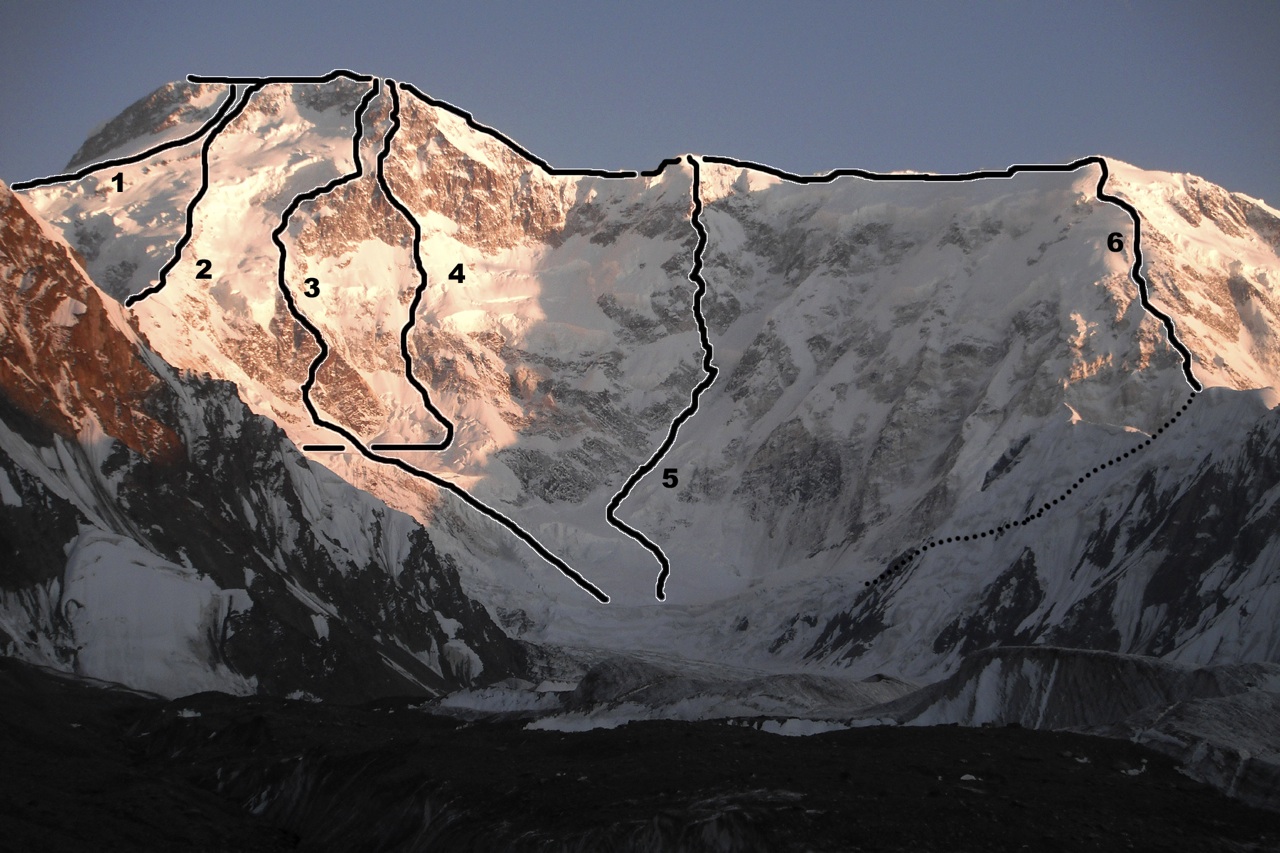Pik Pobeda (7,439m), North Face, Dollar Rod
Asia, Kyrgyzstan, Tengri Tag

After our ascent of Przhevalskogo, the plan was for Boris Dedeshko and I to traverse over Khan Tengri (6,995m) to the South Inylchek Glacier, where Gennadiy Durov would be waiting for us. From there we would attempt a new line on the north face of Pik Pobeda. Gennadiy, a guide, was acclimatized, having already climbed Khan Tengri twice during the season and slept at 6,400m. For Boris and me 6,240m Przhevalskogo was not enough.
Boris and I reached Camp 2 on Khan Tengri’s normal route from the north. There Boris became ill, and he descended to base camp to catch a helicopter out of the area. I continued alone, reached the summit, and camped 12m below. Next day I descended the normal southern route and met Gennadiy at South Inychek base camp, where we spent four days playing cards and eating from others’ tables. We got up at 6 a.m. on August 10 and left for Pobeda.
In 1982 a Kazakh team, led by Vladimir Smirnov, climbed the Dollar Route on the north face [erroneously reported as 1986 in previous AAJs]. We suspect they created this route as a reaction to the Soviet expedition to Everest that year, snubbing their noses at the Himalayan climbers. A direct route up the face to the right had been on the radar of climbers since that time, and I had dreamed of completing it since 1993.
Using snowshoes Gennadiy and I climbed the Abalakov Route to 5,000m, then moved left to a snow terrace, expecting to traverse right next morning toward our proposed line. Unsurprisingly for this region, a strong snowstorm arrived after dinner, avalanches roared past on nearby slopes, and almost in a panic we ran back to the edge of the Pedestal, expecting to be swept away. The storm dropped 60cm of fresh snow. If the bottom part of the route had been less avalanche-prone, we would have returned to base camp with pleasure. However, next day the storm subsided, and we broke trail upward to our planned camp below the seracs, where we spent a leisurely day in the sun.
Late that night we ran on snowshoes under the seracs and avalanche-strewn slopes and then quickly gained height. The fact that nothing fell on us I can only attribute to divine intervention. We climbed four pitches and simul-climbed at least 800m.
We reached the first rock buttress, which we climbed for four pitches (5b-6a), then chopped out a tent site. Next day we completed the final pitch (M4) and mostly simul-climbed hard snow slopes above. We had enough confidence in our partnership that we belayed only five or six times, eventually reaching the left side of a rock rib we dubbed the Mast. At this point we swapped packs. Gennidiy, who had been following with the pack containing all our bivouac gear, now took over and climbed confidently on difficult terrain. At times I could hardly keep up and cursed my old age; he has 10 years advantage. We stopped a little early to dry our gear in the setting sun.
The following morning, after four pitches, we arrived at the foot of a rock wall. To the left it overhung, while directly above rose a beautiful buttress, which we climbed via two serious pitches (6a M4), emerging onto the upper slopes. While we could have easily traversed left to the Dollar Route, we pursued an independent finish and simul-climbed snow interspersed with rocky sections, where we occasionally belayed, for 800m to a final, unexpected, rock wall. Two pitches (5c and 5b), followed by 150m of easy snow and rock, led to the summit ridge.
We left our packs and in cloudy weather reached the top a little after 7 p.m. We were so exhausted and frozen that our only desire was to go down, and our mood was similar to the gray evening. But during the descent the sun suddenly exploded along the horizon, and the world at our feet was bathed in a golden, curling light. We inhaled new strength and by 11 p.m. had reached the west summit and tents of climbers on the normal route. Next day, August 16, we descended the normal route and were in base camp at 1:30 p.m. We called our new line Dollar Rod (2,500m, 3,200m above base camp, 6a M4-M5 WI2).
Denis Urubko, Kazakhstan, supplied by Anna Piunova, mountain.ru
Editor’s Note: While the technical difficulties of the serious Dollar Rod are concentrated in the three rock barriers, much of the upper section features unprotected climbing. Bivouacs were made at 5,000m, 5,100m, 5,250m, 5,900m, and 6,700m during the ascent and at 6,900m on the descent. Urubko feels that due to its high latitude (it is the world’s northernmost 7,000m peak) an ascent of Pobeda is similar to climbing close to 8,000m in the Himalaya. The route was one of six nominated for a 2012 Piolets d’Or.


